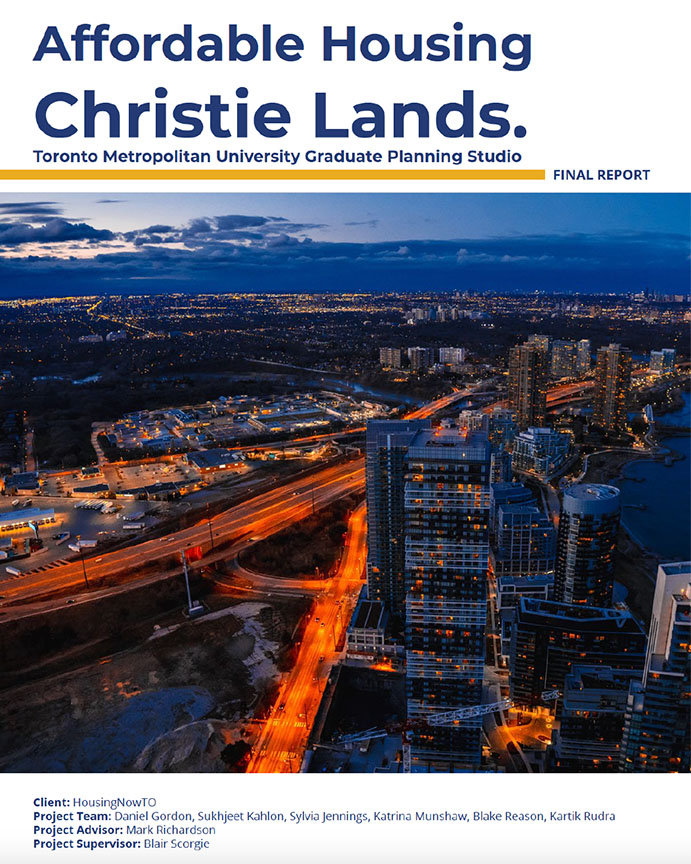Detailed Site Analysis Breaks New Ground for SURP Students
Through its Housing Now Initiative (external link) with CreateTO, the City of Toronto has committed to creating affordable housing on 21 municipally-owned sites. This may sound straightforward, however the reality is anything but.
This spring, six graduate students* enrolled in a studio course at the School of Urban and Regional Planning found out exactly how challenging delivering on this promise will be, by investigating the complexities of a Housing Now pipeline site in Etobicoke. The vacant, triangular, and sloped two-acre site is located within the Christie Lands, adjacent the Humber Bay Shores neighbourhood. It is wedged between the Gardiner Expressway, Lake Shore Boulevard, and an expressway on-ramp. Blair Scorgie, who served as the Faculty Instructor for this assignment, selected the site based on the unique issues, challenges, and opportunities it presents.
The students were tasked with assessing the site and its surroundings from a variety of perspectives including spatial, policy, regulatory, demographic, environmental, servicing and infrastructure, transportation, real estate, financing and development activity. They also engaged with a range of stakeholders and technical experts, including representatives from CreateTO, Toronto Housing Secretariat, Toronto Engineering Services, Enbridge and Canada Housing and Mortgage Corporation. They also spoke with a number of land developers, affordable housing providers, architects, planners, land economists, and academics.
Based on the outcome of their research and analysis, the students prepared a set of five preliminary development options. Each was reviewed and evaluated through a pro forma analysis, which calculates financial viability by comparing a number of variables. Based on the findings of the pro forma analysis, the students identified a preferred development option and prepared an accompanying set of recommendations to implement it.**

The team’s findings can be found in their 122-page report, Affordable Housing, Christie Lands. They note that while the site may be constrained, the potential to build affordable housing here — a stone’s throw from lakeside parks and trails — is great. The site is located in a burgeoning neighbourhood, and adjacent high-density development, amenities and services (existing and planned), a future integrated transit hub and a stretch of Lakeshore Boulevard to be transformed into a complete street. It is expected that a large development planned across the street will bring a library and public schools to the immediate area — major assets in creating and sustaining a diverse community. The report recognizes a pressing market need for more affordable rental housing options in the area, even with (or in fact, heightened by) the intense development activity happening nearby.
“This report is groundbreaking,” says Blair Scorgie. “It effectively illustrates the range and extent of challenges to the delivery of affordable housing, even in instances where the land is already municipally owned. It clearly outlines the breadth of solutions that are required. Many of these fall within municipal jurisdiction, including the relaxation of prescriptive regulations and guidelines, and the expediting of municipal approvals.”

Student Daniel Gordon said, “Planners have to think creatively to tackle the barriers that prevent the delivery of affordable housing, and we need to be open to a variety of solutions to incentivize the housing we want. Speaking with stakeholders, it became clear to us that so many factors need to align in order to enable affordable housing. It was incredible to delve deeper into all of the issues that impact the creation of affordable housing in this project.”
Toronto is the ultimate training ground for future urban planners, providing a wealth of case study opportunities at every point in the development process, and a public sector eager to innovate.
“This project not only demonstrates the amazing ingenuity of our students, but also how our school puts a focus on applied research, offering opportunities to get out of the classroom, build connections in the field and test ideas in the real world,” says Raktim Mitra, Director of the School of Urban and Regional Planning. “I congratulate these students on everything they achieved working together.”

*The students and co-authors of Affordable Housing, Christie Lands are: Daniel Gordon, Sukhjeet Kahlon, Sylvia Jennings, Katrina Munshaw, Blake Reason and Kartik Rudra.
**With respect to the preferred development option, the recommendations address building design, programming, unit mix and size, tenure structure, amenity space, connectivity, parking and operations, and required policy and regulatory changes. With respect to next steps, the recommendations address investment and development partnerships, the streamlining and expediting of development approvals, and the relocation of existing infrastructure.
